Syrian Mercenaries In Ukraine
Summary
This report uses social media, media reports and online interviews to determine the extent of Syrians fighters’ recruitment for the war in Ukraine.
Key findings:
- Fighters connected to the Syrian regime and from the opposition did express their desire to fight in Ukraine.
- No formal recruitment has been observed in opposition-controlled areas.
- Recruitment procedures reported in GoS controlled areas.
- Salaries offered to recruits vary between 1500 - 2500$ per month.
- It has been reported that some individuals are paying 10 - 150$, For their names to be added to the recruitment lists.
- Deployment to Ukraine is seen as an opportunity to escape to Europe in order to seek asylum.
- No actual deployment of fighters to Ukraine has been observed as of end March.
Introduction
Social media networks and platforms have participated in the crisis between Russia and Ukraine, by forming a parallel field of war.
They have also played the biggest role in the army mobilization, or other words, potentially bringing in (recruiting) the mercenaries to participate alongside both parties of this war. The review found evidence of extensive recruitment efforts to fight on the Russian side, with only very limited indication of efforts to fight on the Ukrainian side.
Since the beginning of the crisis, there was a significant increase of both “anti-Ukrainian content” & “anti-Russian” content, especially in the days preceding the invasion. On platforms such as Twitter and Facebook. For example, on February 14, the number of ‘anti-Ukrainian’ posts published on the Twitter platform increased by 11,000% compared to posts published two weeks earlier. Likewise, ‘anti-Russian’ content rose dramatically during the same period. The published content with the negative sentiments including the main keyword (Russia, Ukraine, war, occupation, aggression, invasion) shows as:
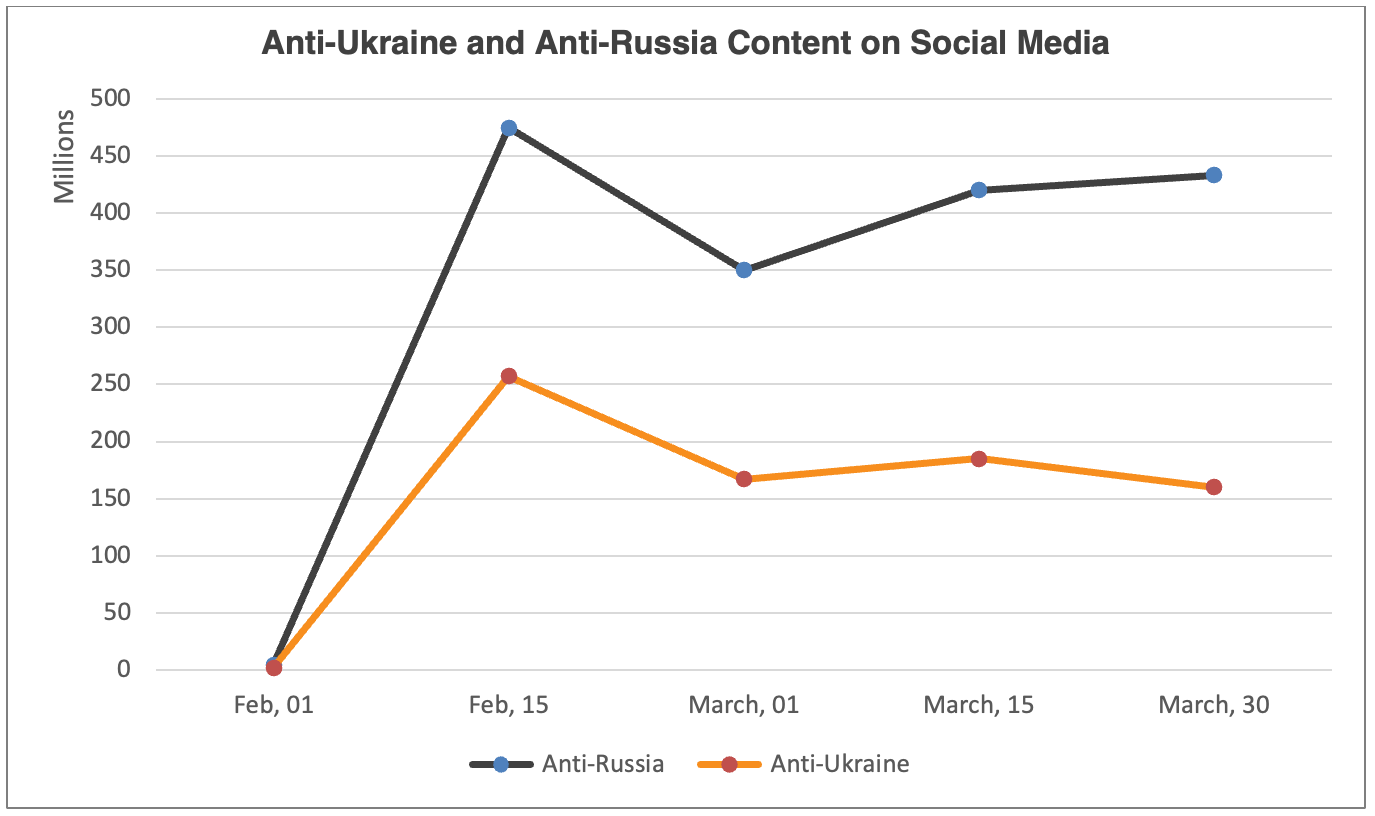
Anti-Ukraine and Anti-Russia Content on Social Media
Social network platforms prove that they are not simply influencing nor conveying public opinion, but have become, because of their millions of followers, an important tool used in the Russian-Ukrainian war, equally or more effective than tanks and warplanes.
In this research, we will analyze and monitor what has been published, regarding the recruitment of Syrian fighters to fight in Ukraine, on various social media platforms, newspapers, radio stations, television channels, news sites, social network platforms, blogs, newspapers, and electronic magazines.
The monitoring process is carried out using monitoring and analysis tools and systems to measure and analyze public opinion interaction and extract scientific indicators that enable tracking of the recruitment process.
The report also presents some interviews with former fighters who participated in the war alongside the Russian army in Libya, in addition to interviews with people living in Syria, in an attempt to track the recruitment mechanism.
Methodology
Scope of monitoring
Social media platforms, in addition to the most prominent accounts and groups concerned, and online media platforms during the period from the beginning of February to the end of March.
Monitoring tools
Several monitoring tools have been used to cross-check the published information, ensure interaction rates, and calculate the average number of posts during 60 days. The tools include brand24, keyhole, Awario, Audiense, CX Social, Tweet Reach, Geo-fence netbased.
Subject timeline
Although the war began on February 24, the electronic war began several weeks earlier, with a significant rise in keywords such as (Russia, Ukraine, war, occupation) starting in late January. With the start of the war, the dramatic rise in the use of those keywords within the scope of people using social media channels among Syrians was evident. The following chart shows the increase of the reach using the keywords mentioned before.
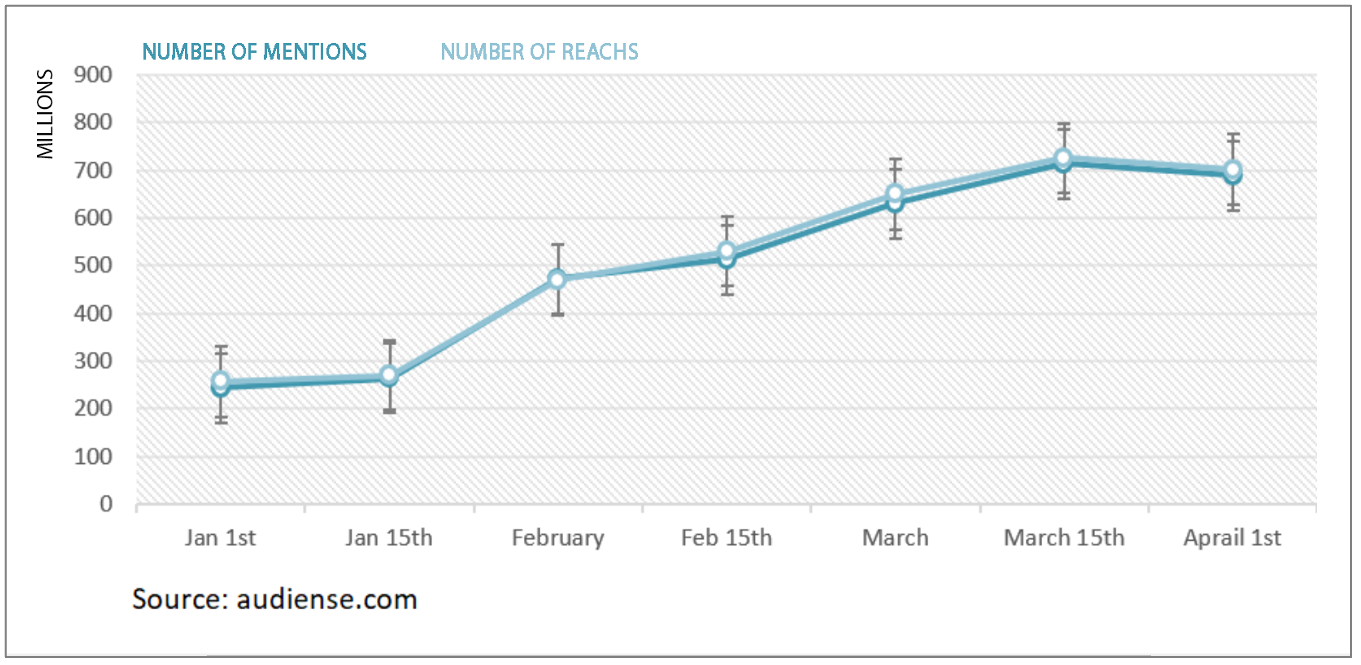
Timeline of content mentioned (Russia, Ukraine, War, Occupation) on social media
There was a marked increase in the prevalence and expansion of the conversation at any major military event. As the Russian war on Ukraine entered its 22nd day on March 17, Ukrainian intelligence confirmed the start of the transfer of mercenaries from Syria in preparation for being thrown into combat alongside the Russians, which led to a significant rise in the talk about the war and the validity of the news or its denial. The following chart shows the increasing number of mentions and reaches regarding the mercenaries’ news.

Number of Mentions & Reach of (Russia, Ukraine, Mercenaries) Keywords on Social Media
Overall analysis
Social media source
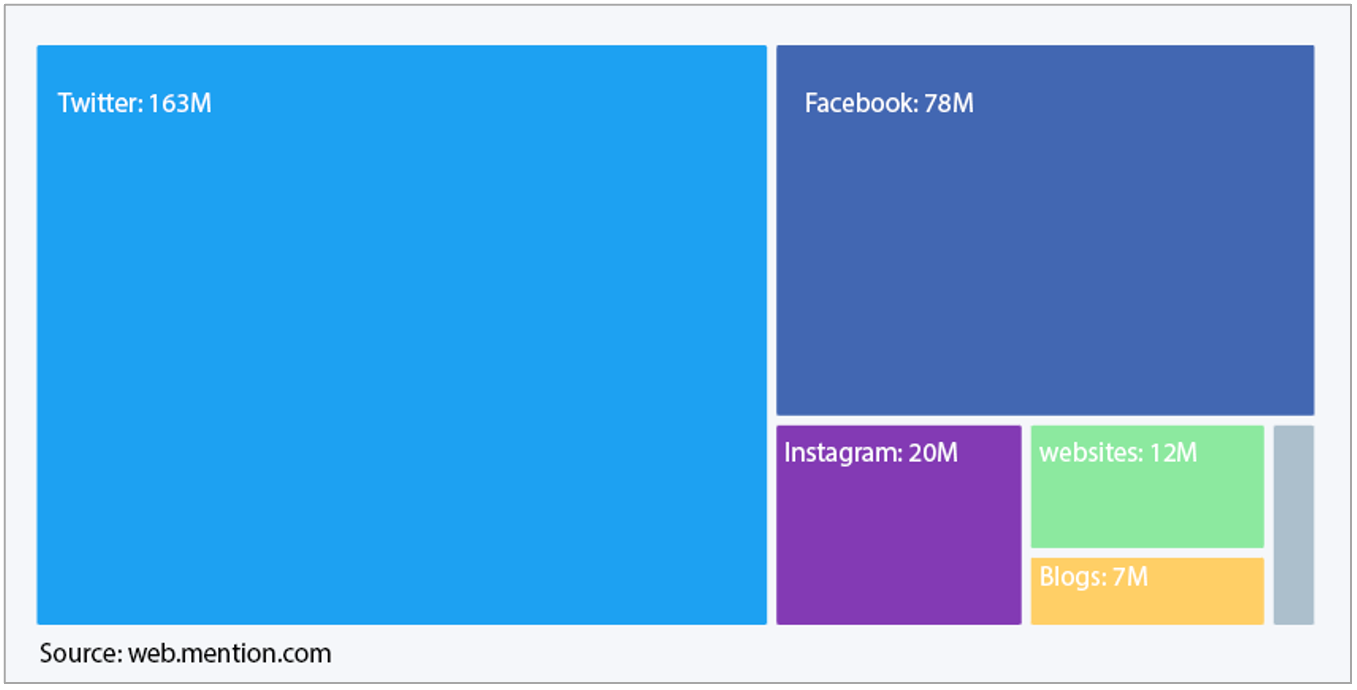
Number of Mentions & Reach of (Syrian Mercenaries, Syrian Fighters, with Putin, Z) Keywords on the Internet
In the chart, we have the sources where keywords were fetched, these figures reflect the direct keyword circulation rate related to the Russian-Ukrainian war as well as additional words such as Syrian mercenaries, Syrian fighter, with Putin, Z.
Demographics
Gender By location
This graph shows the distribution by gender and its difference versus the location of Syrians who had a place in the discussion about the war using the same keywords mentioned before. Two-thirds of participants inside Syria are male, while outside Syria there were slightly more female than male participants.
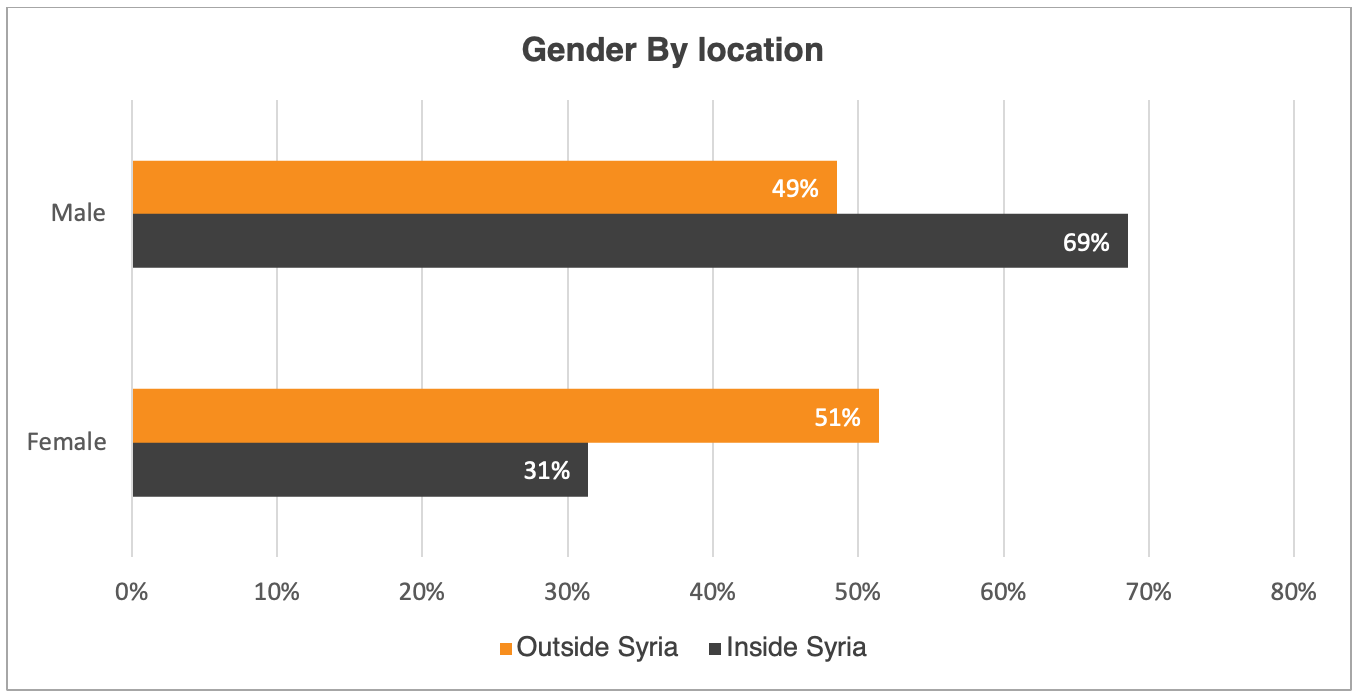
Gender by Location
Age groups
By measuring the last 60 days of keyword discussions (Russia, Ukraine), the majority of participants were between the ages of 18 and 34 years, and were distributed as follows:
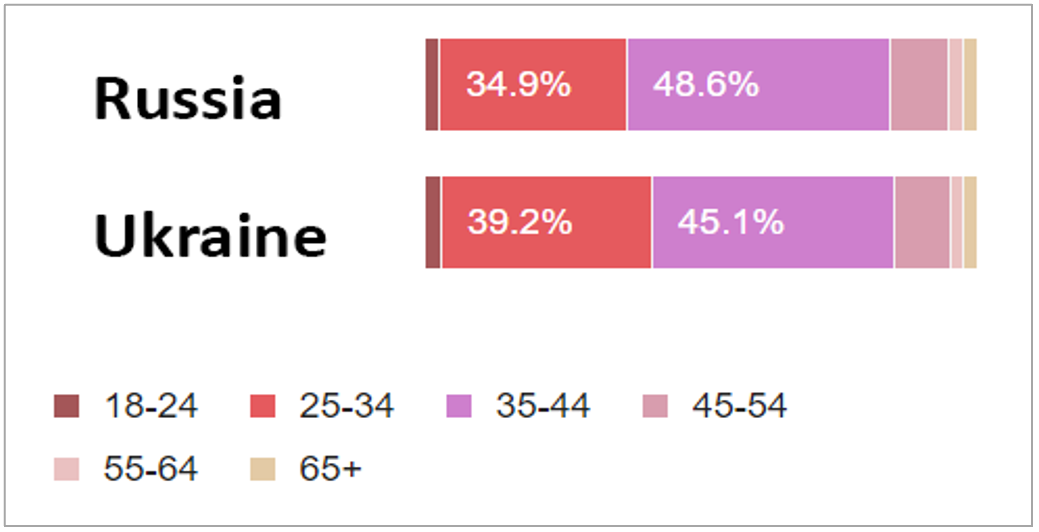
Age Groups of Syrians that Mentioned (Russia, Ukraine) on Social Media
Sentiment
This graph shows the differentiation between the sentiments that were noticed while analyzing the content shared on the social media channels over the last 30 days, using the main keyword with the baseline: Syrian fighters, Syrian mercenaries, National army, the Syrian army, Syrian group. Overall, sentiments were strongly negative.

Sentiments of Posts on Social Media with Baseline
(Syrian fighters, Syrian mercenaries, National army, the Syrian army, Syrian group)
Public opinion
The decision of recruiting or volunteering thousands of Syrian fighters to go and fight in Ukraine has spread considerably, especially after Russian President Vladimir Putin announced his country's readiness to receive fighters who want to fight alongside Russia. However, there are no assurances that Syrian mercenary fighters will arrive either to fight with or against Russia.
New York Times published confirmations that more than 300 Syrian army troops from the elite Fifth Corps had arrived in Russia for military training before heading to Ukraine3.
Here we cover the public opinions put forward by political or military, governmental or semi-governmental bodies, loyal to or opposed to the Syrian regime that contributed to the discussion about Syrian fighters in the Russian-Ukrainian war.
Syrian fighters against Russian offensive
The Defense Ministry of the opposition’s interim government denied1 sending any Syrian fighters to fight against Russia in Ukraine, saying the reports were aimed to discredit the National Syrian Army fighting the Russian occupation in Syria.
Suhail Hamoud, a famed FSA fighter who is nicknamed “Abu TOW” for his skill in operating the American anti-tank missile BGM-71 TOW, recently offered his assistance to Ukraine2.
Syrian fighters in support of the Russian offensive
According to the Syrian Observatory for Human Rights, Russia has prepared lists of more than 40,000 fighters belonging to pro-Syrian regime groups to be ready to take part in the Ukrainian war alongside the Russian army. The Observatory quoted6 activists as saying that "recruitment centers were established in Syria in cooperation between Russian and Syrian military personnel and pro-regime groups in several provinces, most notably in Damascus and its countryside and in Homs to Deir-ez-Zor."
The debate began effectively when a special force loyal to the Syrian regime and a national defense force in the city of As-Suqaylabiyah, Syria, published a denial4 of news about its accession to fight in Ukraine, through the group's military commander Nabeel Al-Abdallah, after a report published by Al-Jazeera confirmed that the military group is fighting in Ukraine, and the leader of the group announced that they are ready to fight in Ukraine if requested.
Many posts confirmed the start of the registration process in many Syrian provinces for fighters wishing to go to Ukraine to support Russian forces. A post of the As Suwayda A N S5 talked about an office in the city center that already started to collect names; the person mentioned (Weaam Zarefa) who participated in the decision confirmed through comments that the registration has already begun and that the registration fee is 30 thousand Syrian pounds (12$) but no one has been sent to Ukraine yet. He confirmed that the mission of these groups will only be to protect facilities without participating in combat missions; he did not specify the locations.
In an interview with people in Latakia, Nour confirmed that the security offices deployed in the city began collecting names and these offices began to request fees for registration, these fees range from $10-100, and these fees vary according to the task that will assign to the fighters, from a guard mission to combat missions. Other reports state that while the recruitment process was free until the transfer outside the country, the security offices and centers charge fees ranging from $10-150, depending on the region to which the transfer will be made.
Since the beginning of this year, Hezbollah has begun recruitment of young Syrians in Homs as fighters, after a security study by the Syrian Intelligence Service, and a combat course inside Lebanese territory; says Ali from Homs.
The recruitment is only for military services inside Syria, especially in Tadmor and Ar Raqqah, and they call them ISIS snipers, but He did not rule out using these forces in the Russian war. “Mainly, these young people join the fight to get the salaries offered, up to $2000 if they are transferred outside the country, or a monthly salary of $200 if they are fighting inside Syria” he said.
While there is no official confirmation regarding the arrival of Syrian military groups in Ukraine, pictures of the first Syrian soldier killed in Donbas province, were published by pro-Syrian regime journalist Rafik Lutf (picture). The post was deleted after a few hours due to some official statements that denied the news and confirmed that the soldier identified was killed in 20157.

Pro-Syrian Regime Journalist Rafik Lutf
Announcing the Martyrdom of the First Syrian Soldier in Donbas, Ukraine
In another video8, a Syrian pilot is jumping with a parachute announcing his arrival in Russia. The video has been posted with some information about the pilot; his name, origin, and comment on his arrival to Russia as the first step before his relocation to Ukraine.
We have tried to reach the main source of this video to verify and confirm the information, however, we found out that none of the published information is verified or confirmed. One of the received comments9 denies that the soldier's family name is true or even known in his town (picture)

A Comment Denying that the Existence of the Soldier's Name in the Town Where he is Supposedly From
Testimonies from mercenaries obtained by Syrians for Truth and Justice (STJ) match flight logs of aircraft that left Benghazi (Libya) to Damascus International Airport, on the eventual route from Syria to Russia, Report 10 was published by STJ who interviewed someone who was a commissioned guard stationed in Benghazi city, the source mentioned that around 150 fighters (without specifying their nationalities) were transferred to Syria to be sent to Russia and after that to Ukraine in different areas.
Divergent views in this regard have been expressed, British intelligence says Russia's Wagner Group deployed to eastern Ukraine, “They are expected to deploy more than 1,000 mercenaries, including senior leaders of the organization, to undertake combat operations,” Britain’s Ministry of Defense said(picture).
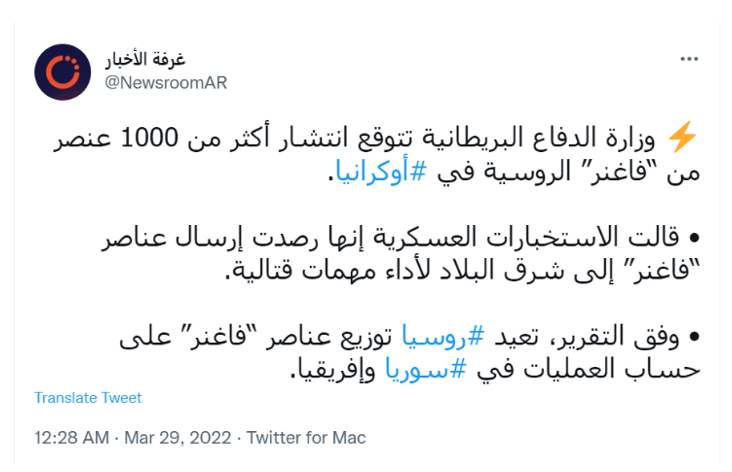
Syrian Newsroom Announcing Wagner Group Deployment to Ukraine. Reports taken from British intelligence & British Ministry of Defense
Won't happen again
In an interview with former fighters who participated in Russian military operations in Libya, they assured us that they had not reached out to the offices responsible for recruitment because Russia returned them to Syria after they have been transferred to Libya to join the Russian forces and finishing the contracts period, which is estimated to serve for 4 months. Oussama added that the contract mentioned that their monthly salaries would range from $1,000 to $1,500, but the majority received only $3,000 for four months, and a few received amounts ranging from $4,000 to $5,000.
Amer who spent 2 months in Tripoli refused to join the war in Ukraine, “they would leave us at checkpoints on the desert road with one or two meals a day. And after I came back, I only received 800 euro out of 2,500 promised” he said.
Hidden intentions
The people we spoke to confirm the fact that the main goal of the people who register their names to go to Ukraine is to shorten the distance and time to reach Europe. Previous recruitment was carried out by persons directly associated with Russian forces and through the offices of the Syrian Army Fifth Corps. However, today registration is done through many centers or people known to have links with the Syrian regime.
Contractors assure people who register that their chances of reaching Europe are greater due to the policy of European countries to receive refugees as a result of the war. Some offices confirm to volunteers that if they are transferred to Ukraine, they will be put in touch with people on the Ukrainian border who will help them with transport out of Ukraine to reach Europe to apply for asylum.
- https://www.facebook.com/permalink.php?story_fbid=152304223913727&id=100074024509088
- https://twitter.com/suheilhammoud/status/1497199703641014272
- https://www.nytimes.com/2022/03/31/world/middleeast/syrian-mercenaries-ukraine-russia.html
- https://www.facebook.com/watch/?v=364675792172597
- https://www.facebook.com/Suwayda.IamaHumanStory/posts/488793982655416
- https://www.syriahr.com/%D8%A7%D9%84%D9%85%D8%B1%D8%B5%D8%AF-%D8%A7%D9%84%D8%B3%D9%88%D8%B1%D9%8A-%D9%84%D8%AD%D9%82%D9%88%D9%82-%D8%A7%D9%84%D8%A5%D9%86%D8%B3%D8%A7%D9%86-%D8%B1%D9%88%D8%B3%D9%8A%D8%A7-%D8%AC%D9%86%D8%AF/476034/
- https://www.enabbaladi.net/archives/555850?fbclid=IwAR0Q6qUOwZRgYifyPmat13-vKw_NqMGhtsaqrNOWxmRgtStBa1c52d0o168
- https://twitter.com/tommycats4/status/1508551230108454923
- https://www.facebook.com/100071590578137/videos/299899025586238/
- https://stj-sy.org/ar/%d8%a3%d9%88%d9%83%d8%b1%d8%a7%d9%86%d9%8a%d8%a7-%d8%a8%d8%af%d8%a1-%d8%b9%d9%85%d9%84%d9%8a%d8%a7%d8%aa-%d9%86%d9%82%d9%84-%d9%85%d9%82%d8%a7%d8%aa%d9%84%d9%8a%d9%86-%d8%b3%d9%88%d8%b1%d9%8a%d9%8a/